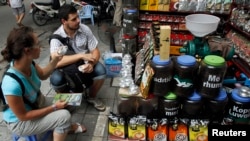Bich Ngoc loves Instagram food shots like any other self-respecting millennial, but not just for their photogenic allure: She gets on social media to check if certain cuisine is safe. Ngoc, 18, is among the growing number of Vietnamese who have become increasingly alarmed at the perils lurking in their rice bowls. She follows social media influencers, as well as reads comments on the review site Foody, when deciding whether to trust a particular restaurant, brand, or dish.
“As I understand, our health is very important,” she said. “If I have a stomachache, a small one is OK but for a bad one, I’d have to get treated. So it's better to prevent this than to get sick.”
Food scandals are common in Vietnam, and businesses and consumers are looking for solutions as the scandals mount. Street vendors have been known to reuse cooking oil so many times it becomes toxic. Video clips have been posted showing a merchant dyeing vegetable greens to make them more colorful. And more recently, the mixing of battery chemicals with coffee and pepper led to five arrests in April.
Food Safety Problems are Widespread
Problems with food safety cost Vietnam $740 million in productivity and top the list of worries among the public, according to the World Bank. Cases of lost productivity range from employees who get sick and must stay home from work, to farmers who must throw out crops that go bad or chickens that die prematurely.
From romaine lettuce in California, to strawberries in Australia, no place is immune to food risks. But in Vietnam, the risks are seen as less of a fluke and more of a sadly common reality. Rare is the diner who has never experienced food poisoning in the country of 100 million people. And the poisonings can happen whether one is eating on a sidewalk stool, or at a five-star hotel.
Chain Stores vs. Open Markets
These concerns explain the changing face of Vietnam’s food and beverage sector. Eatery chains like Pho Hung noodles or Thai Express are multiplying. And there has been an explosion of convenience stores, with 7-Eleven entering the communist country in 2017 to compete with America’s Circle K, Japan’s Family Mart and Vietnam’s Coopmart.
Customers recognize the brands and believe, rightly or not, that it is safer to buy clams and okra packaged in plastic, in an air-conditioned shop, than at the open market.
Similarly the spread of full-scale grocery stores gives shoppers the assurance of consistency.
“The issue is how to adapt to [customers’] demands,” said Le Thi Minh Trang, quality director at Auchan Vietnam supermarkets.
She said her company sources 90 percent of its inventory domestically, controlling quality by holding suppliers to certain standards. For example, some must have GAP, or Good Agricultural Practices, certification, and others are beholden to the company’s list of prohibited items.
Other businesses trying to improve sanitation levels include C.P. Vietnam, known for farmed products like eggs and duck meat. It is focusing on traceability, so people can follow their purchase throughout the supply chain.
Misuse of Chemicals
There is also Phoenix, a large rice trading company, which is fighting the indiscriminate blanketing of rice fields with pesticides and herbicides. It is working with farmers to drain fields early so they don’t need as much fungicide to kill mold.
“A lot of agrichemicals are being used in Vietnam,” Vivek Sharma, Phoenix vice president in Southeast Asia, said last week at a food safety conference in Ho Chi Minh City put on by the World Bank’s International Finance Corporation.
But there is also the potential for overkill, or unfortunate consequences of the push to make food safer. Just as businesses jumped on the “organic” label bandwagon in the United States, so are Vietnamese store fronts slapping “organic” or “green and clean” on their signs for the branding benefit, with no guarantee they are selling anything of the sort.
Open Air Markets still Strong
However, Vietnamese still buy 80 percent of their food from traditional markets, according to the World Bank.
That includes Nguyen Ngan, who sells snacks like fish balls and quail eggs from a box hitched to his motorbike. As a shopper he said he can’t afford supermarkets, but also likes open-air markets because he can buy fresh products directly from farmers and fishermen.
“I think the fish is of good quality, I eat it and don’t have any problems,” Ngan, 51, said.
But Vietnam hasn’t reached the balance of, say, Thailand, where street food is affordable but considered relatively safe. So Vietnamese will look for clean options, especially as alternatives to what they consider cheap and unsafe imports from China. Consumer surveys show Vietnamese are increasingly willing to spend more money on safer food. According to the World Bank, this is the biggest concern for locals, even more important than issues like corruption or the cost of living.






